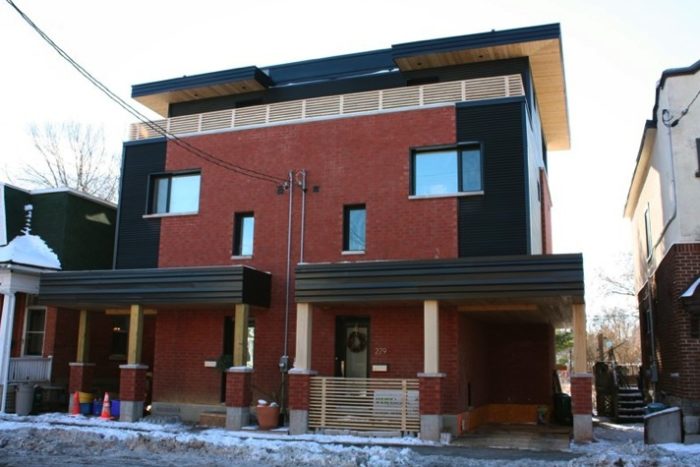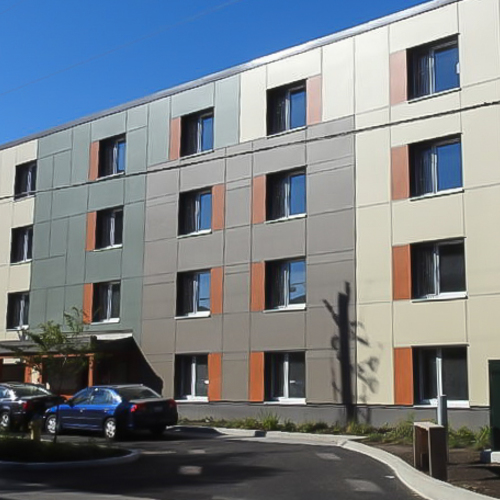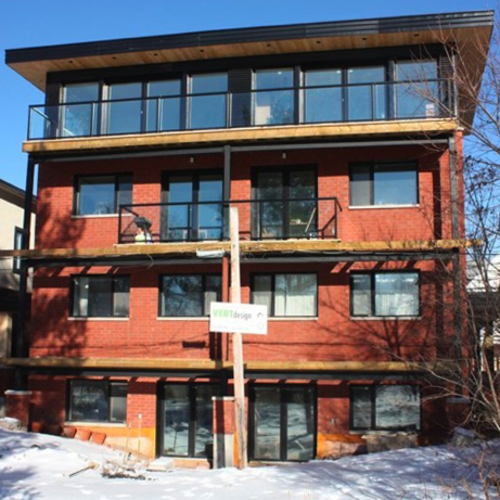
Image Credit: All images Vert Design Inc.
Image Credit: All images Vert Design Inc. The heavily glazed back of the Rideau Residences duplex. More than 95% of the material in the preexisting house on the site was reused or recycled. High-weight-bearing R-10 foam enclosed the footing. An elastomeric waterproof membrane was applied to the footings and the full height of the foundation walls. Prefabricated wall-panel modules were used for the exterior walls. An exterior-wall cross-section: 3.5-in. brick; 0.75 in of wood strapping rain screen with brick ties; 4 in. of foil-faced polyisocyanurate rigid insulation (R-22), with joints sealed; 0.44 in of oriented strand board sheathing; 2x6 wood frame (16 in. on center) with 3.5 in of closed-cell polyurethane spray foam insulation (R 21); and 0.5-in. gypsum board. Tapered polyisocyanurate insulation was installed over the roof deck to provide a drainage plane. The project’s dual-core heat recovery ventilator. The HRV includes a highly efficient electronically commutated motor and a high-efficiency particulate air filter. More than 90% of the glazing on the south-facing wall is completely shaded in summer and unshaded in winter using a variety of shading systems, project designer Vert Design says. The second-floor kitchen. The third-floor living space, looking south through fixed and tilt-and-turn triple-glazed windows.
Chris Straka, principal at Vert Design in Ottawa, Canada, apparently didn’t intend to meet the Passivhaus standard when he built his three-story duplex in the city’s Edinburgh neighborhood. Straka had consulted on dozens of green residential projects before starting his own company in 2006, and the main goal on this one, an infill project known as Rideau Residences (which overlooks the Rideau River), was to stay on budget while applying green building principals to most aspects of the project, from the deconstruction of a preexisting building on the lot to the reuse and recycling of materials to the implementation of conservation and energy efficiency measures in the new building.
Ross Elliott, owner of Homesol Building Solutions, which offers Passivhaus consulting and certification in the Ottawa area, points out on his company’s website that colleagues told Straka that trying to build the duplex to the Passivhaus standard in the southeastern Ontario climate would be financially impractical. So he aimed instead for LEED for Homes Platinum certification, used conventional materials available in Canada, and tended to construction details as best he could to make the building energy efficient. He spent about $251 U.S. per square foot, which, he noted, is about 10% above the cost of a typical custom project in the Ottawa area.
Backing into Passivhaus certification
Straka hired Ross to evaluate the energy efficiency of the building, whose two units each offer about 1,500 sq. ft. living space, and the two discovered it performed to the Passivhaus standard. “My goal was to build a building I could be proud of, not necessarily to build a Passive House,” Straka said, but added: “I knew that a very high performing building could be created using Canadian materials and mechanical systems.”
The project, which Ross says is the first residential project in Canada to earn Passivhaus certification (see our story on Austria Passive House), also includes radiant-heat floors, a geothermal heat pump to supplement the building’s heat recovery ventilator, room for a cistern for rainwater collection, and a 1,200-sq.-ft. green roof with 12 in. of soil. A solar power system will be installed in the spring. According to the Vert Design website, the building has in fact been certified LEED Platinum. The website includes a slide show featuring many of the images highlighted here, as well as floor plans.
Weekly Newsletter
Get building science and energy efficiency advice, plus special offers, in your inbox.















5 Comments
Congratulations! Lets hope
Congratulations! Lets hope for many more.
Very nice project.
The best green model housing ever shown on GBA. Community and context are as essential as insulation and weatherproofing. Study and learn, people!
Rideau Residences
A truly "Built Green" building.....great job
Insulation Board
Can you put insulation boart under the footings? Won't that destabilize the footings? I would like to use concrete sips when I build my last house but didn't think I could put insulation under the footings. Can anyone help me here?
Bob
[email protected]
Response to Robert Nemoyer
Robert,
Here's an article that answers your questions: Foam Under Footings.
Log in or create an account to post a comment.
Sign up Log in